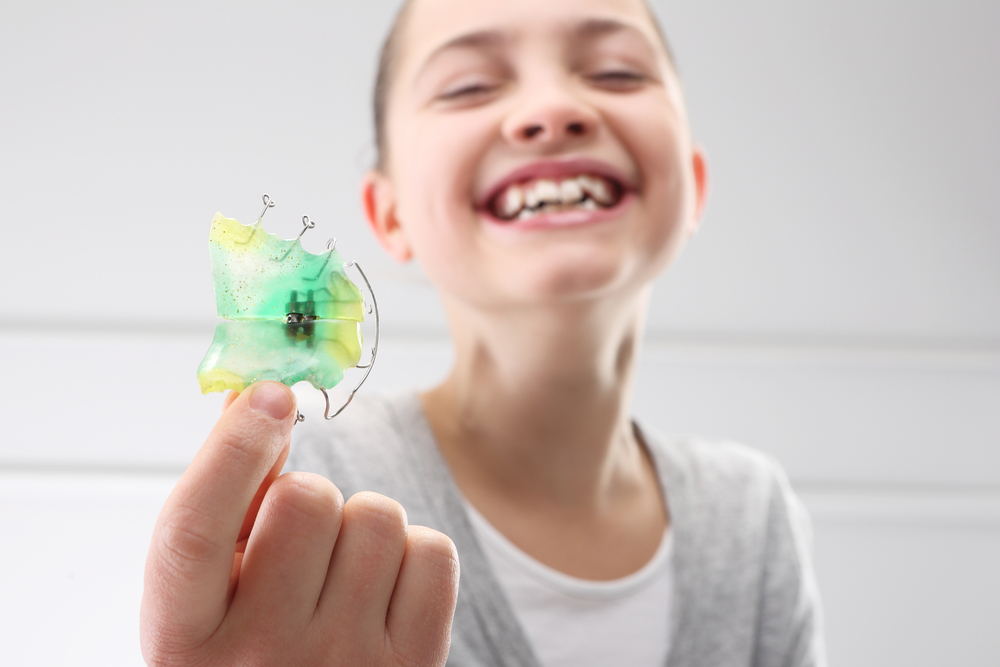
When should a child see an orthodontist? The American Association of Orthodontists recommends kids have their first orthodontist appointment when parents notice signs of an orthodontic problem or, as you probably guessed from the title of the post, no later than age 7. A referral from your dentist can help with specific concerns, but a referral isn’t necessary.
About Your Child’s First Orthodontist Appointment
Most of the time, when your kiddo first visits Dr. Jeff at his office in El Dorado Hills, he’ll examine their bite, jaws, and teeth, and chat with you both about what he sees, marking the beginning of an observational period and fun times at the Jeffrey Kwong Orthodontics (JKO) office.
You’ll come back about every six months, so he can keep an eye on any concerns he had at your initial examination and let you know when it’s time for your child to start treatment.
One of the persisting myths in orthodontics is that all the permanent teeth need to be in before the straightening process begins; however, that’s often not the case, and early evaluation is the key to age-appropriate treatment. This service is complimentary, and the appointments will be quick and easy.
Every so often, if an issue is spotted, visiting an orthodontist at age 7 ensures we’re able to step in early during a child’s active growth. At this point, we can much more easily guide the development of the teeth and jaws to prevent complex orthodontic issues down the road.
This early interceptive treatment is what’s known as two-phase treatment. The first phase is generally used to address jaw concerns and consists of wearing an appliance, such as an expander or braces, for about a year, followed by a resting period where we monitor the child.
We do our best to limit the use of braces during the first phase unless they are an absolute necessity. Then, in phase two of treatment, your little one will go through the normal course of braces or Invisalign Teen, followed by wearing a retainer to maintain their results.
Whether your child falls into the observational period camp or they need two-phase treatment, these early visits will put them on the path to a healthy smile for life. Now that we’ve covered the basics, let’s move on to the why behind the age 7 recommendation.
Here are 7 reasons to book your child’s first orthodontist appointment by age 7:
1. We can identify extra or missing teeth
The first orthodontist appointment includes an exam by Dr. Jeff with photos and digital x-rays. One thing we’re looking for is that a child’s teeth are falling out and erupting according to schedule.
Seeing an orthodontist at age 7 lets us identify issues like extra or missing teeth when we can still take action and keep your child’s oral development on track. Teeth might not be visible because they’re just slow to erupt. Depending on the child, it may take as long as six months for a grown-up tooth to come in after a visit from the Tooth Fairy.
If primary teeth are lost early, the resultant crowding may need to be addressed by removing permanent teeth if caught too late. In all of these cases, when a child is actively growing and still has baby teeth, it’s easier for us to use appliances like a space maintainer, retainer, or braces to allow the permanent tooth to make its debut exactly where we want it.
In other instances, teeth can love your little one’s smile so much, an extra one (or two!) show up. These are called supernumerary teeth or extra teeth. They are commonly found blocking front teeth from erupting. So, when extra teeth are present, they usually need to be extracted, and if they cause eruption or alignment issues, phase one or early interceptive treatment could be indicated to correct the problem.
2. Correct harmful habits
A child’s first orthodontist visit is a great time to ask your orthodontist about potentially harmful oral habits like finger and thumb sucking, teeth grinding, tongue thrusting, mouth breathing, and prolonged pacifier or bottle use. We’re trained to offer guidance to parents on stopping these habits before they cause irreversible damage.
For example, finger and thumb sucking have been associated with narrowing of the jaws and crossbite (an upside-down bite), while tongue thrusting has been linked to an open bite and premature wear of the back teeth. The longer the habit continues, the worse the bite can get.
We can give you advice on different behavioral techniques you can use and, if all else fails, there are really effective habit-breaking appliances that physically block the behavior.
3. Guide tooth eruption
The x-rays we take at a first orthodontist appointment show us a child’s unerupted teeth and their position below the gum line.
If it appears that teeth don’t have room to come in at all or they’ll come in at odd angles, a proper treatment plan can create the right environment for them to aid in their eruption. This can have a significant positive impact on their future treatment and overall results.
When enough space is created, there is a high chance that we can avoid the extraction of permanent teeth. And, we can often use braces or clear aligners alone when they start phase two treatment to give them a healthy, stable bite, and a beautiful or handsome smile.
4. Correct jaw growth problems and sleep disorder breathing (sleep apnea)
If you’re wondering how old to see an orthodontist is too old? The answer is, it’s never too late to achieve a smile you love, and we can successfully straighten your teeth at any age.
With that said, when it comes to correcting issues with the jaw, there’s a huge advantage to early intervention. When you’re an adult who is done growing and you have a severe jaw size imbalance, options become more limited, and surgery may be required to address your bite concerns.
Bites like underbites are especially important to have evaluated and treated early. Interceptive orthodontic treatment can guide the growth of the jaw while it’s still developing because jaws are more easily manipulated, allowing children to avoid surgery or complicated treatment as grown-ups.
We use a number of appliances to correct problems or imbalances with jaw growth in order to fit all of the permanent teeth and relate the upper and lower jaw to each other. This brings about lasting, dramatic results.
If your child is snoring, gasping for air when sleeping, having difficulty staying awake during the day, waking up feeling unrefreshed, or is bed wetting, these may be signs of sleep apnea. Sleep apnea is a serious breathing disorder where breathing during sleep stops and restarts repeatedly.
Orthodontists can work together with sleep doctors and E.N.T.s to help in treating such problems. Recent research has shown that the orthopedic expansion of the upper jaw may be helpful in improving sleep disorder breathing.
5. Make room for crowded teeth
Crowded teeth can be due to jaws that aren’t large enough to accommodate the permanent teeth, teeth that are just too big, or the early loss of primary teeth.
As we noted earlier, when a primary tooth is lost before its time due to injury or decay, the adjacent teeth have a habit of shifting to fill in the space. This can block the permanent tooth from erupting properly and cause crowding.
When there are signs of crowding at your child’s age 7 orthodontist visit, there are a few different solutions.
Depending on the severity of space loss, it could be as simple as waiting and observing, or it may be more involved, using appliances to hold space, regain space, or expand the jaws.
It’s important to have an evaluation to make a proper diagnosis. When the permanent teeth are ready to come in naturally, they’ll have room, and your child’s orthodontic treatment in their teen years will be straightforward and faster.
6. Boost self-esteem
Having spacing, an imbalance in the jaw, or crooked, crowded teeth can make a child feel self-conscious during their formative years. It doesn’t help that bullying is so prevalent in person and online.
Studies have shown that teeth are frequently the targeted feature of bullying. While two-phase treatment is most often used when there are functional or developmental issues, the cosmetic benefits are important too!
When a kid likes their smile and feels good about themself, they get a huge boost of confidence that carries over into their school, activities, and relationships for life.
7. Prevent damage and trauma to the teeth and gums
When the front teeth stick out too far, which is evident at a 7-year-old’s first orthodontist visit, we can take steps to decrease the protrusion and start to correct the overbite early on. Teeth that protrude are more susceptible to damage from trauma, and it also has social implications for kids.
Dental trauma has lifelong dental and financial ramifications, and can involve root canals, crowns, bone grafting, and implants. Also, it is challenging to provide esthetics for broken or knocked-out teeth until the patient’s growth has stopped and an implant can be placed.
Other issues, like significant crowding and spacing, make teeth harder to clean and can lead to gum disease, even in children. If phase one treatment is needed, we can create a healthier oral environment and make teeth less prone to accidents.
Book Your Child’s First Orthodontist Visit in El Dorado Hills, CA Today!
When you’re debating about what age to see an orthodontist for your child, 7 isn’t a hard and fast minimum. We offer free consultations at Jeffrey Kwong Orthodontics, so if you’re concerned about how your child’s teeth are coming in before this age, book a visit.
We’ll perform an exam, take complimentary digital x-rays, if necessary, and walk you through the diagnosis (if there is one). Our offices are kid- and adult-friendly, and Dr. Jeff and the team are fun, welcoming, and knowledgeable. You and your child feel at ease and informed every step of the way.
Schedule a visit at our El Dorado Hills orthodontic office today and give your child the gift of a healthy, beautiful smile. No referral is necessary; simply book online or by calling us at (916) 933-0532.


Join the discussion 2 Comments